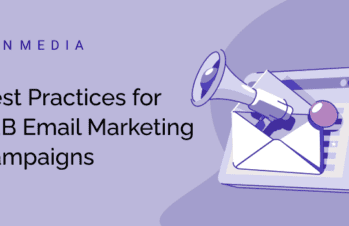We’ve talked before about the growing importance of outreach in the world of online marketing—promoting your own blog or business website by guest writing on someone else’s site. It’s an extremely effective way to tap into new audiences and attract more people to your site.
Related reading: How to Use Digital PR to Build A Relationship With Influencers
What is an Outreach Email?
An outreach email is a message that is sent to a specific individual or group of individuals with the goal of establishing a connection or relationship. Outreach emails are often used in business and professional settings, but they can also be used in other contexts.
Examples of outreach emails include:
- Reaching out to a potential employer to express interest in a job opening
- Contacting a journalist or blogger to pitch a story idea
- Inviting a speaker to participate in an event
- Networking with other professionals in your field
- Introducing a new product or service to potential customers
The First Step to Email Outreach
The hard truth is that you’ll never even get the chance to write a guest blog or do much at all if you don’t get the first step of the outreach process right. That first step is writing an email to the owner of the site.
Think about it. If you’ve determined that a particular site would be the ideal place for a stint as a guest blogger, you can be sure that plenty of other people have, too. And all of those other people are also sending the site owner emails requesting to guest blog. So if you want even the faintest hope of ever being given the chance to widen your audience via that site, you’ve got to absolutely make sure that your outreach email stands out from all the others.
So how can you ensure that your message catches the site owner’s attention—and not only that but also merits a positive response? We’ve put together a list of some outreach tips for writing the perfect outreach email to help you on your way.
15 Effective Email Outreach Strategies
1. Pay attention to the subject line!
If you stumble on this all-important first step of the process, the game’s already over. Writing a spammy-sounding subject line or one that is off-putting in any way is likely to land your outreach email in the trash folder without so much as a second glance.
Be straightforward in your subject, letting the recipient know exactly what awaits him inside. Being mysterious is a red flag for spam. If possible, let him know what kind of time commitment he’s looking at in dealing with your email, as well—“Quick Question—Guest Blog Idea” is much more likely to be opened and read than “Thought we might start a discussion about the possibility of guest blogging.” How you craft the email, especially the guest post outreach subject line, will make all the difference in your request reaching its recipient.
Related reading: 11 Email Marketing Strategies That Guarantee a 50% Click-to-Open Rate
2. Personalize a greeting.
The best way to draw someone in to read the rest of your outreach email is to use their name. Starting right into your request without a greeting or even going with a generic “Hi!” will not inspire much hope that your email isn’t just a mass mailing. Go old-school and use “Dear So-and-so” or even “Hi, So-and-so” to gain the reader’s attention.
3. Do your research.
Yes, it’s definitely important to read at least a few of this person’s blog posts before emailing them about guest writing. But going beyond that is what will make your email stand out. Do some research about the site owner exclusively. Find out what they do, their background, their family, etc. Maybe you’ll find you have something in common that you can use to make a real connection—and at the very least, you’ll be able to mention something from the owner’s life to show them on an even deeper level that this is no mass outreach email.
4. Get to know their network.
Even if you have no connection with the site owner—and let’s face it, you probably won’t—you can forge one by getting to know someone from his network. Check out his LinkedIn profile, and see if you already know anyone who also has a connection with him. And if not, try to establish contact. Look at their other social media channels, as well. Once you’ve found a mutual friend, don’t just name-drop. Run your guest blogging idea by that mutual connection, and see if they think it’d be a good fit. If they like it, you can also include that nugget of gold in your email.
5. Give your opener genuine context.
Whether or not you’ve mentioned the site owner’s background or a mutual friend, your opening paragraph has to make the context of your request clear. What is it about the site that makes it the perfect place for you to guest blog? Which past blog posts did the site owner write that you found especially useful or pertinent to your topic? This first paragraph should prove beyond a shadow of a doubt that you not only read this person’s blog regularly but also understand their focus and their audience.
6. State just one goal.
Even if you’re just bursting with ideas for guest blogs, reviews, interviews, etc., don’t give in to the temptation to mention them all in this first email. This is important to remember when learning how to write an outreach email. Choose the one central goal you have—in this case, writing one guest blog post for her site—and only ask for that. Overwhelming the site owner with five different requests simultaneously will probably start those warning lights flashing—this person wants way more than I can give them—and will likely lead to a ‘no.’
7. Give your unique angle.
This part is just as important as establishing a context for your request. Sure, you may understand the site owner’s audience and focus, but if the guest post you propose sounds just like the posts that blogger writes every week, why on earth would he publish it? In your outreach email, tell him how your blog idea takes his focus and approaches it from a unique angle—one that only you can provide because of your specific expertise.
8. Be persuasive.
Don’t beg, but don’t get bossy, either. Instead, use your powers of persuasion to show the blogger what’s in it for them. How will their audience benefit from your guest post? How will they benefit from it?
9. Don’t overdo the close.
When you sign off, put your name, title, and a link to your website, and that’s it. Don’t add a pile of other links or a bunch of pictures; keep it simple and professional.
10. Be brief.
This piece of advice goes for the entire outreach email. If your note rambles on endlessly, your chosen blogger might just give up and stop reading. Each section—your personalized opening, single request, and persuasive pitch —should be as succinct and to the point as possible. Take a look at a few outreach email examples to see how they crafted their message.
11. Keep your email basic.
Adding images or any kind of formatting will raise warning flags in a site owner’s mind—they shouldn’t have to click “display images” just to read your email. Keep it simple and easy for everyone involved.
12. Use inviting language.
This can be one of the trickiest areas to navigate, but it’s also probably the most important of all in an outreach email. It’s vital to be friendly, polite, and concise simultaneously. Yes, you want to be succinct, but you also don’t want to sound rude. Instead of saying something like, “I want to write a guest post for you sometime before next Friday,” try softening it by saying, “I’d love it if we could discuss my writing a guest post for you sometime.”
13. Be easy to reach.
You want the person you’re emailing to respond to you so use a clear and branded signature. Include your name, title, and contact information in a clear, branded signature at the bottom of the email. Take it a step further and make it easy for them to take action. Start by including a clear call-to-action and make it easy for the recipient to follow through.
When you send that outreach email can be an important factor in whether it gets opened and read, too. Mondays can be too busy, and on Friday, most people are just wrapping things up for the weekend. Sending your email on a Tuesday morning, for example, is a good way to have it pop up in the site owner’s inbox at a time when they’ll be more receptive.
14. Timing is important.
When you send that outreach email can be an important factor in whether it gets opened and read, too. Mondays can be too busy, and on Friday, most people are just wrapping things up for the weekend. Sending your email on a Tuesday morning, for example, is a good way to have it pop up in the site owner’s inbox at a time when they’ll be more receptive.
15. Follow-Up
When it comes to following up on an outreach email, it’s important to strike a balance between being persistent and being respectful of the recipient’s time and inbox. If you don’t hear back after a reasonable amount of time, follow up to ensure the recipient received your email and to answer any questions they may have. Take the step, but remember not to be overly persistent.
Related reading: The Pros and Cons of Cold Outreach Emails
What experiences have you had with writing and sending outreach emails? Do you have any other tips to share or even your own outreach email template? Maybe you have received these emails yourself and would like to share what the successful ones had in common? We’d love to hear from you in the comments section below.





